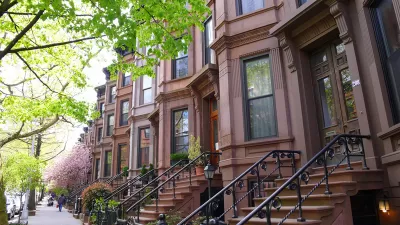Say what you will about the gentrification of Brownstone Brooklyn, but there's no question that Everett and Evelyn Ortner's regard for the neighborhood's historical treasures had a significant influence on its evolution over the past 50 years.
With the recent passing of Everett Ortner, Elizabeth A Harris pens an appreciation for the couple's "early and vigorous" promotion of Brooklyn as "a historic site worth preserving and a collection of neighborhoods worth nurturing."
Beginning in the early 1960s, at a time when "Manhattanites still considered it an unacceptable place even to go for dinner," the Ortners embarked on their decades-long effort to preserve and improve western Brooklyn, and especially Park Slope, including "gathering up young couples from Manhattan and persuading them to buy old, shabby brownstones in Brooklyn, even as their neighbors fled for the suburbs." Of course those brownstones, purchased for anywhere between $18,000-$25,000 (about $170,000 in today's dollars) in the mid-1960s now sell for several millions of dollars.
"While their home surely increased in value as the neighborhood flourished," notes Harris, "they never sold it, nor did they have children to whom they might have bequeathed it...But even without a financial incentive, their success was tremendous - perhaps, in some ways, more extravagantly so than they might have wanted."
"'Everybody here seems to have so much money,' said Dr. Susan Stewart, a friend of the Ortners who has lived on their block since 1973. Of Mr. Ortner, she said, 'He preferred it when it was more of a mixture of people.'"
"Sometimes, she said, he would wonder aloud, 'What have we wrought?'"
FULL STORY: A Couple Who Gave Brownstones New Life

Planetizen Federal Action Tracker
A weekly monitor of how Trump’s orders and actions are impacting planners and planning in America.

Restaurant Patios Were a Pandemic Win — Why Were They so Hard to Keep?
Social distancing requirements and changes in travel patterns prompted cities to pilot new uses for street and sidewalk space. Then it got complicated.

Map: Where Senate Republicans Want to Sell Your Public Lands
For public land advocates, the Senate Republicans’ proposal to sell millions of acres of public land in the West is “the biggest fight of their careers.”

Orange County, Florida Adopts Largest US “Sprawl Repair” Code
The ‘Orange Code’ seeks to rectify decades of sprawl-inducing, car-oriented development.

Maui's Vacation Rental Debate Turns Ugly
Verbal attacks, misinformation campaigns and fistfights plague a high-stakes debate to convert thousands of vacation rentals into long-term housing.

San Francisco Suspends Traffic Calming Amidst Record Deaths
Citing “a challenging fiscal landscape,” the city will cease the program on the heels of 42 traffic deaths, including 24 pedestrians.
Urban Design for Planners 1: Software Tools
This six-course series explores essential urban design concepts using open source software and equips planners with the tools they need to participate fully in the urban design process.
Planning for Universal Design
Learn the tools for implementing Universal Design in planning regulations.
Heyer Gruel & Associates PA
JM Goldson LLC
Custer County Colorado
City of Camden Redevelopment Agency
City of Astoria
Transportation Research & Education Center (TREC) at Portland State University
Camden Redevelopment Agency
City of Claremont
Municipality of Princeton (NJ)





























